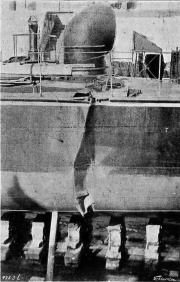1895 "Built at Birkenhead by Messrs Laird Brothers. She is one of the later and larger 30 knot destroyers, being 213ft. 6 in. long and 21 ft. 7 in. wide. Her displacement is about 300 tons, and her indicated horse-power about 6000. Her complement is 58 men."[1]
1897 On 20 August 1897, Thrasher collided with the cruiser Phaeton in the English Channel, killing one crewmember.[2]
1897 "On September 29 the two vessels, (Thrasher and Lynx) whilst cruising from St. Ives to Falmouth, the Thrasher leading, both ran on the rocks of Dodman Point, there being a thick fog at the time. There is some doubt as to the speed at which the vessels were steaming before breakers were seen. Previously the speed had been 12 knots. The signal had been made to reduce this to 10 knots, but the vessel went ashore before it was hauled down. The officer of t he watch on board the Thrasher estimated that the speed when the vessel actually struck was about 7 or 8 knots, and that the engines had then been going astern 10 seconds."[3] The grounding caused a steam main aboard Thrasher to rupture, killing four stokers. While both ships were refloated, Thrasher was badly damaged and after repair was no longer as fast as her sister ships. The ship's commanding officer, Commander Travers, was severely reprimanded by the resulting court-martial.[4]




